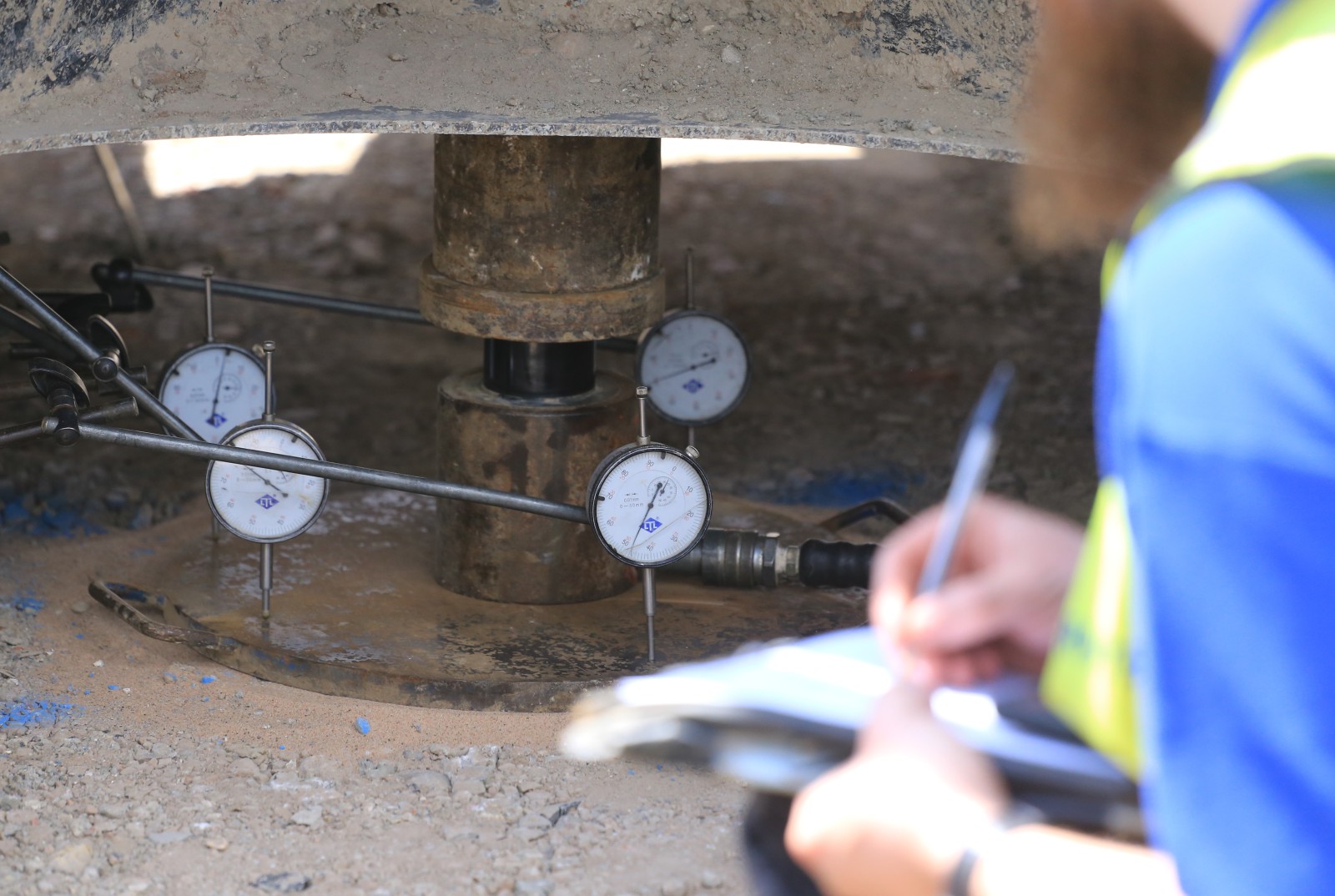
In-situ Services
In-situ tests are conducted directly on the ground, rock, or soil at a construction, investigation, or infrastructure site. These tests are used to gather information about the geotechnical properties of the site, such as compaction, strength, stiffness, permeability, and deformation characteristics.
USES
In-situ testing is important because:
It can provide valuable information for the design and construction of foundations, roads, and other structures.
It can be used to ensure project specification requirements are being met in Earthworks projects.
It can help to identify any potential hazards that may be present at the site, such as unstable ground or hidden voids.
BENEFITS
Benefits of in-situ geotechnical engineering testing
Accuracy: Tests are conducted on the ground in its natural state.
Efficiency: In-situ testing Results are made available much faster to ensure projects can progress with minimal delays
Cost-effectiveness: In-situ testing is often more cost-effective, especially for large projects where various tests are required.

We offer a comprehensive UKAS accredited site testing service at Igne and can deliver all types of in-situ geotechnical engineering testing services, including:
Density Tests
Density testing is carried out to determine the mass of material that can be placed into a given volume and usually to assess the degree of compaction of material on site. This is done by monitoring the bulk density, dry density, and moisture content.
We need to monitor the density because if the ground is not achieving the appropriate compaction, then after a period of time settlement due to loading can cause serious problems and this will inevitably be expensive to rectify.
There are 3 main common density tests carried out
Nuclear Densometer Gauge:
This is performed by radioactive sources emitting radiation from a probe inserted into the compacted ground which is then received by sensors inside the gauge. The source in the base of the gauge sends out neutrons and a sensor only measures those that return slowed by hydrogen to work out moisture content. The other source at the end of the probe sends out gamma rays, the denser the material the less reach the sensor in the gauge. The densometer combines this data to calculate the bulk density, dry density, and moisture content. NDG tests can normally be performed on coarse, medium, and fine-grained material.
Sand Replacement Test:
This is performed by excavating soil using a fixed template as a guide and replacing it with fine sand of a known density and carrying out a calculation to determine a bulk density. After oven drying, the sample moisture content can be determined and thus dry density can be calculated.
Core Cutter Test:
This method is usually the simplest method of in-situ density testing. The core cutter has a known volume and is pushed into the ground so the material fills the cutter. The cutter is then removed and trimmed and recovered back to the lab where it is weighed to give a mass of soil. The material is oven dried to determine the moisture content enabling dry density to be determined.
Moisture Condition Value (MCV)
The MCV test was designed to remove selection difficulties of material which were intended to be used as fill material and to aid in the selection of suitable and unsuitable materials. It is a common test used both in the field and in the lab. The MCV test gives a good indication of the soils workability at its current moisture content and reduces the chances of a failure of material.
In-situ CBR
The in-situ California bearing ratio test is a penetration test designed to evaluate the strength of road subgrades. The result gives an indication on how much deformation a road will suffer due to the loading and pressures of vehicles wheels. This information is used to determine requirements for pavement thickness and subgrade layers.
Plate Bearing Test
The Plate Bearing test, also known as the plate load test is commonly used to determine properties including strength, ground bearing capacity and modulus of subgrade reaction (k). It can also be used to provide an estimated equivalent CBR value which enables assessment over a greater surface area than a traditional CBR plunger and allows material with larger particle sizes to be tested.
Dynamic Cone Penetrometer (DCP)
The dynamic cone penetration (DCP) test provides a measure of a materials in-situ resistance to penetration. The test is used to determine the structural properties of sub-grade materials beneath road pavements.
The DCP test equipment is robust, easy to use, portable and suitable for use in locations where access may be restricted. The test is performed by driving a metal cone into the ground by repeated striking with an 8kg weight dropped from a distance of 575mm.
Light Weight Deflectometer
The light weight deflectometer (LWD) can be used to provide a rapid in-situ assessment of the foundation surface modulus or stiffness in MPa (E) used in pavement design. It can also be useful in compaction control for base layers and sub-bases.
The advantages of the LWD are that it is a self-contained, light weight, easily portable piece of equipment allowing testing to be carried out without the use of kentledge and where vehicular access is difficult/impossible.
Groundwater and Gas Monitoring
Groundwater and Gas Monitoring is used to measure the depth and level of groundwater and the presence of any gases in the soil or groundwater. Groundwater monitoring is typically performed using wells or piezometers. Gas monitoring is typically performed using probes or sensors.
Standard Penetration Testing (SPT)
The Standard Penetration Test (SPT) is a test used to determine the relative density and strength of soil. It is performed by driving a split-spoon sampler into the soil and counting the number of blows required to drive the sampler a certain distance. The SPT value is calculated by dividing the number of blows by the distance driven.
Permeability Testing
Permeability Testing is used to measure the rate at which water can flow through soil. It is performed by passing water through the soil and measuring the flow rate. The permeability of the soil is calculated by dividing the flow rate by the cross-sectional area of the soil sample and the hydraulic gradient.
Infiltration Testing
Infiltration Testing is used to measure the rate at which water can infiltrate into the soil. It is performed by excavating a trial pit, filling with water and measuring the rate at which the water disappears. The infiltration rate of the soil is calculated by dividing the change in volume of water over time by the area of the pit.
FREQUENTLY ASKED QUESTIONS
What are the applications of in-situ testing?
Earthworks: Compaction control and specification compliance assessment.
Site investigations: In-situ testing is used to investigate the ground conditions at a proposed development site. This information is then used to design and construct the foundations and other structures in a safe and economical manner.
Road and pavement construction: In-situ testing is used to investigate the ground conditions along proposed road and pavement routes. This information is then used to design and construct the roads and pavements in a way that will withstand the expected traffic loads.
Slope stability analysis: In-situ testing is used to assess the stability of slopes. This information is then used to design and implement slope stabilization measures, if necessary.
Environmental assessment: In-situ testing is used to assess the environmental impact of proposed developments. This information is then used to develop mitigation measures, if necessary.
What is the difference between in-situ testing and laboratory testing?
In-situ testing is conducted directly on the ground at a particular site, while laboratory testing is conducted on samples of soil or rock that have been brought back to a laboratory.
Why choose Igne for your in-situ testing?
Igne is a leading provider of in-situ geotechnical engineering testing services. We have a team of experienced and qualified engineers and technicians who are able to perform a wide range of in-situ tests. We also have a fleet of state-of-the-art equipment that allows us to provide accurate and reliable results.
We understand that every project is different, so we work closely with our clients to develop a testing plan that meets their specific needs.
We also offer a variety of other geotechnical engineering services, such as foundation design and slope stability analysis.
For more information regarding any of our in-situ solutions, contact Igne today
Email: hello@igne.comCall: 0371 789 1000

